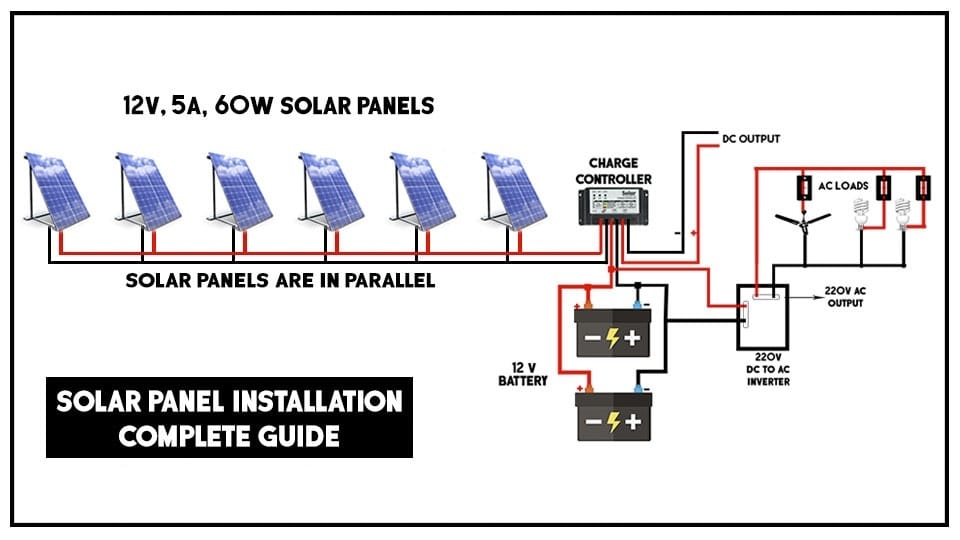Solar Installation Guide

Installing a solar power system is a significant step towards reducing energy costs and contributing to a more sustainable environment. This guide provides a comprehensive overview of the solar installation process, from initial planning to final commissioning, ensuring that your solar system is installed efficiently and safely.
Step 1: Initial Planning and Assessment
1.1. Energy Needs Assessment
- Objective: Determine the energy requirements of your home or business.
- Actions:
- Review past electricity bills to understand your energy consumption patterns.
- Consider any future energy needs, such as electric vehicles or home expansions.
1.2. Site Evaluation
- Objective: Assess the suitability of your property for solar installation.
- Actions:
- Sunlight Exposure: Measure the amount of sunlight your property receives. Ideal sites have minimal shading and direct sunlight for most of the day.
- Roof Condition: Inspect your roof’s age, material, and structural integrity. Ensure it can support the weight of solar panels.
- Space Availability: Determine if there is enough space for the number of panels needed to meet your energy goals.
Step 2: System Design
2.1. Choosing the Right Components
- Objective: Select the appropriate solar panels, inverters, and mounting systems.
- Actions:
- Solar Panels: Choose between monocrystalline, polycrystalline, or thin-film panels based on efficiency, cost, and space.
- Inverters: Decide between string inverters, micro-inverters, or power optimizers to convert DC to AC power.
- Mounting Systems: Choose roof-mounted, ground-mounted, or tracking systems based on site conditions.
2.2. System Sizing
- Objective: Calculate the size of the solar power system needed.
- Actions:
- Estimate the total energy production required to meet your needs.
- Design the system to cover a percentage of your energy usage, considering factors like budget and space.
2.3. Electrical Layout
- Objective: Plan the wiring and connection of the system components.
- Actions:
- Create a wiring diagram that connects solar panels, inverters, and the electrical grid.
- Ensure that the layout minimizes energy loss and complies with electrical codes.
Step 3: Permits and Approvals
3.1. Local Permits
- Objective: Obtain the necessary permits before installation.
- Actions:
- Contact your local building authority to understand the permitting requirements.
- Submit detailed plans of the installation, including site layout and electrical design.
3.2. Utility Interconnection
- Objective: Coordinate with your utility provider to connect the solar system to the grid.
- Actions:
- Apply for interconnection approval, providing technical details of the system.
- Understand the terms of net metering or other grid connection agreements.
Step 4: Installation Process
4.1. Mounting System Installation
- Objective: Secure the mounting structure on which the solar panels will be placed.
- Actions:
- For roof-mounted systems, install the racking and ensure it is securely attached to the roof.
- For ground-mounted systems, set up the foundation and mounting poles.
4.2. Solar Panel Installation
- Objective: Install the solar panels onto the mounting system.
- Actions:
- Carefully lift and place the panels on the mounting racks.
- Secure the panels in place, ensuring they are properly aligned and angled to maximize sunlight capture.
4.3. Wiring and Electrical Connections
- Objective: Connect the solar panels to the inverters and the electrical system.
- Actions:
- Run electrical wiring from the panels to the inverter(s).
- Connect the inverter to the electrical panel and the grid, following safety protocols and code requirements.
- Install a solar meter if required by your utility company.
Step 5: System Testing and Commissioning
5.1. System Testing
- Objective: Ensure the solar power system is functioning correctly.
- Actions:
- Perform a series of electrical tests to check for proper voltage, current, and power output.
- Verify that the system is producing energy as expected and that all connections are secure.
5.2. Inspection and Approval
- Objective: Obtain final approval from local authorities and utility companies.
- Actions:
- Schedule an inspection with your local building authority to review the installation.
- Work with your utility company to complete the interconnection process and start using the system.
Step 6: Monitoring and Maintenance
6.1. Monitoring System Performance
- Objective: Track the energy production and efficiency of your solar system.
- Actions:
- Install a monitoring system to keep track of real-time energy output.
- Regularly review performance data to ensure the system is operating efficiently.
6.2. Maintenance
- Objective: Keep the solar system in optimal working condition.
- Actions:
- Clean the solar panels periodically to remove dust, debris, and other obstructions.
- Inspect the system regularly for any signs of wear, damage, or malfunction.
- Schedule professional maintenance as needed to ensure long-term reliability.


